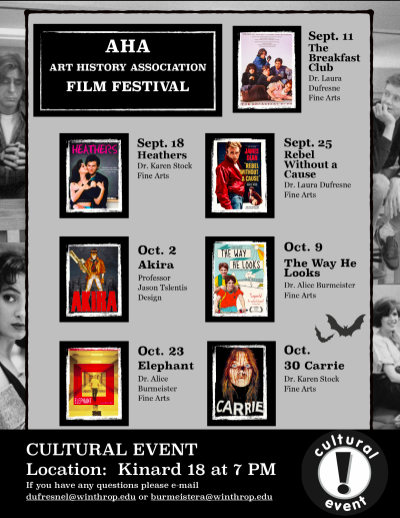With each generation of new media there are those that aim to capture the feeling of the day and be granted the ultimate badge of nostalgic favorite. Whether intentional, like the recent film “Eighth Grade” or unintentional, like “High School Musical,” films like these help garner a sense of longing for the feeling of growing up. Teen angst in media is one of the ways we can reflect on what teenage life was like by capturing the feeling of the day or showcasing outdated stereotypes of certain cliques and clichés. However, it is important to see how media could reflect the struggles of a teenager throughout generations of film and see how it relates to current and former teens living today.
Winthrop’s Art History Association (AHA) is hosting their annual film festival in Kinard auditorium every Tuesday until the final film on October 30th at 7pm with the common theme of teen angst. Some of the films on the line-up for this film festival include “The Breakfast Club,” “Carrie,” “The Way He Looks,” and “Rebel Without a Cause.” Each event is approved for cultural credit. This film festival started at Winthrop University because of art history professor Laura Dufresne, who got inspiration for a film festival from visiting other colleges eight years ago.
“I saw that every college I visited had a film festival and I wanted to bring an event like that to Winthrop,” Dufresne said.
The organization met last spring semester to discuss theme for this year, with previous themes including films with female directors and films from Asia.
“When we got together, we had different ideas. We found a compromise with teen angst as to market to incoming freshmen,” Tabitha Young, AHA president said.
With the choice of teen angst, the film festival hopes to look at the films throughout the decades to see if these films reflect adolescence well and if they are still relevant today.
“As art historians, we view film as an art form. Providing historic context and pointing out elements students should look for in the film, both in regard to subject and style, assists with that process,” said Dufresne.
During each event, the films will have an opening and closing discussion between the presenting professor and the audience with the themes and situations in the film and how they hold relevance toward teenage growth.
“The professors leading each film will use the talks to show a viewpoint or issue a student can take away from the event,” Young said.
One example is the 1985 film “The Breakfast Club” directed by John Hughes, which centers around five students from different cliques as they discover they have similar problems growing up while in detention for different reasons. Professor Dufresne hosted a discussion after the movie on how certain stereotypes would be foreshadowed or expanded years after the film was released and which characters resonated with the audience more than others.
“We had several of stereotypes in the film, such as the nerd, the popular girl, and athlete. We wanted to see if those stereotypes still hold relevance today and if they evolved,” Dufresne said.
With the theme of teen angst, AHA was tasked with choosing a select number of films, considering the format and foreign films.
“I think that the biggest challenge was the vast amount of films [regarding teen angst as the subject], as we wanted to add different formats and media,” Young said.
The idea of film as a form media can serve as a reflection of a society’s cultural norms and explore a time when a generation’s sense of norms could have either evolved or still resonate with students today.
“It is an art form, and if foreign, exposes students to a different culture, their aesthetics and social concerns, etcetera. If an English language film, we look at the decade it was made and how that helps us understand the film,”” Dufresne said.
Professor Jason Tslentis will be hosting the fourth film of the festival, the 1989 Japanese anime and critic and cult favorite, “Akira” on Oct. 7th at 7p.m.




